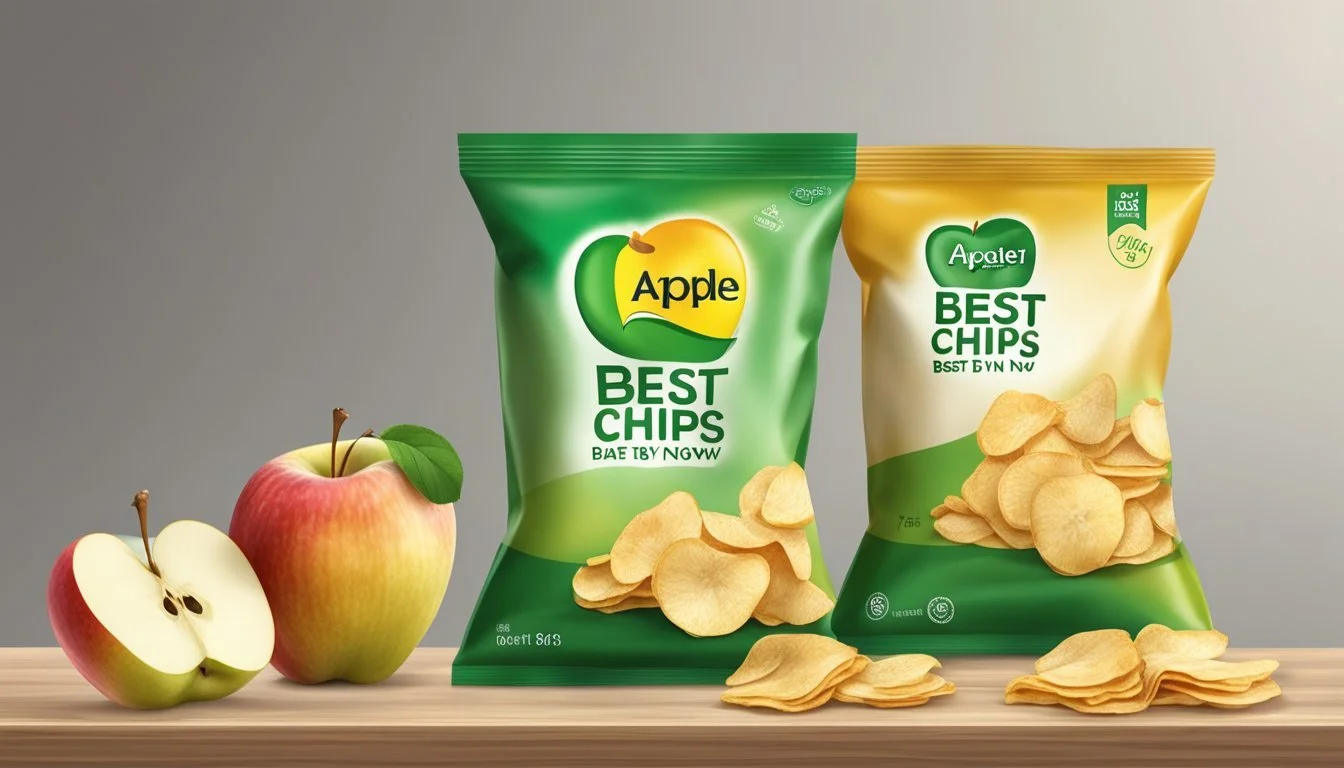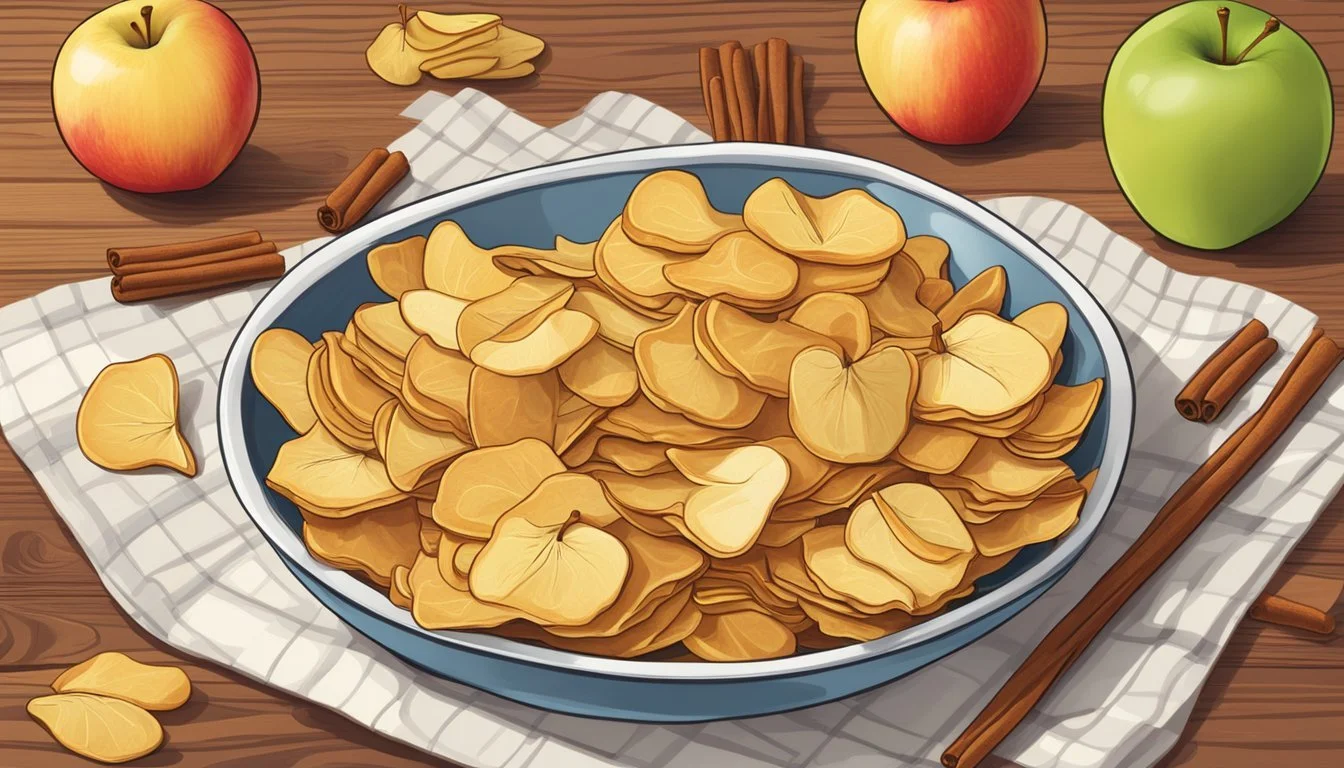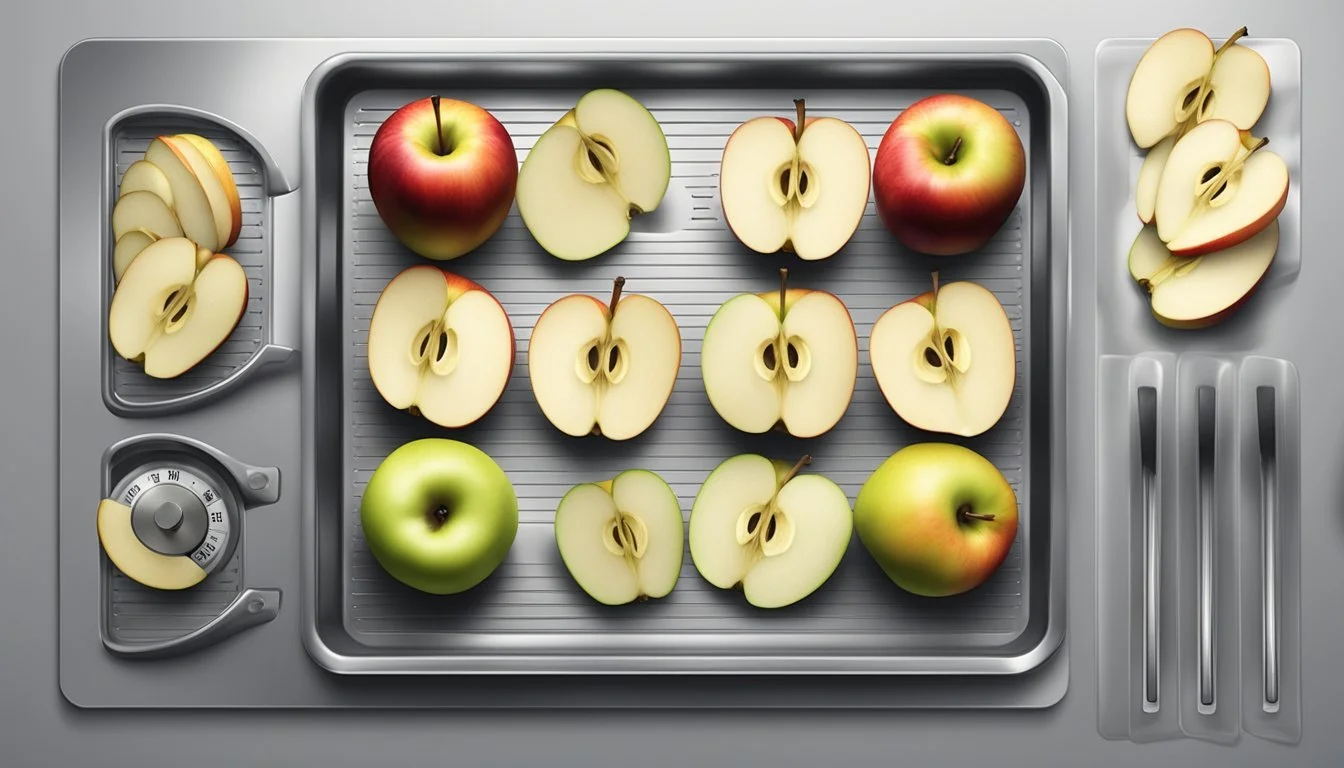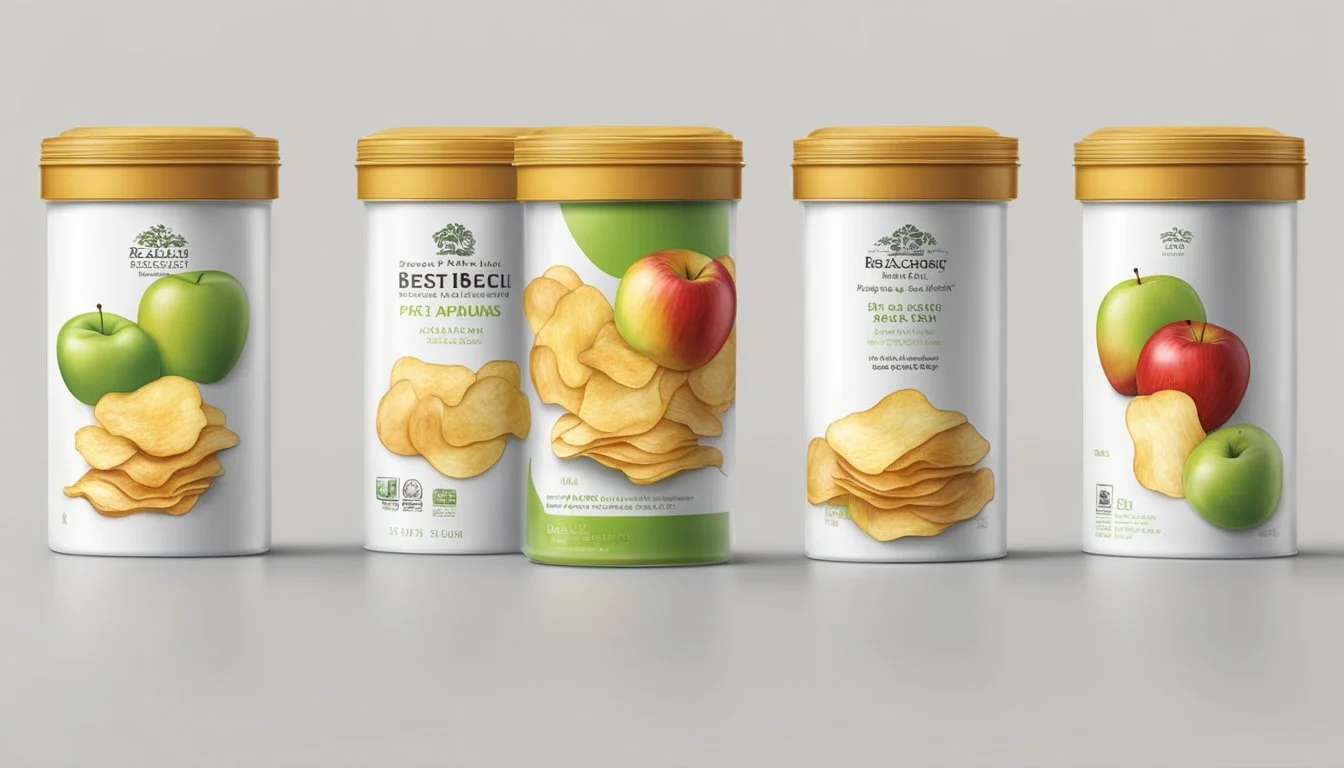How Long Do Apple Chips Last?
Understanding Their Shelf Life
Apple chips are a popular healthy snack that offer a nutritious and delicious alternative to traditional potato chips or sugary treats. Made by thinly slicing apples (how long do apples last?) and then baking or dehydrating them until crisp, they provide a satisfying crunch and a naturally sweet taste. When it comes to preserving such snacks (What wine goes well with snacks?), the question of shelf life is a key consideration for consumers looking to maintain freshness and avoid food waste.
The longevity of apple chips is influenced by the methods used to prepare and store them. Properly dehydrated apple chips, when stored in an airtight container in a cool, dry place, can last for several months. Refrigeration can extend their shelf life further, allowing them to remain fresh for anywhere between six to twelve months. It is essential for the container to be sealed correctly to prevent moisture and air from affecting the quality of the apple chips.
Monitoring the condition of stored apple chips is crucial, as signs of moisture or change in texture may indicate spoilage. As a shelf-stable product, apple chips are a convenient snack option for those seeking a healthy and durable food item, whether it's for packing in lunches, taking on hikes, or simply enjoying at home.
Benefits of Apple Chips
Apple chips are a nutritious alternative to traditional snacking options. They provide a convenient way to enjoy the flavors of fresh apples coupled with the satisfying crunch of a chip, without the added fats often associated with potato chips. Here are some key nutritional benefits:
Low in Calories: Typically, apple chips have fewer calories than many processed snacks, making them a better choice for calorie-conscious consumers.
Fiber Content: They are a good source of dietary fiber, essential for digestive health. Fiber assists in regulating digestion and can contribute to feeling full, which may help in maintaining a healthy weight.
Natural Sugars (how long does sugar last?): The carbohydrates in apple chips come primarily from natural sugars, providing a quick source of energy without the additives found in many sweet snacks.
Vitamins and Minerals: Apples are a natural source of various vitamins and minerals:
Vitamin C boosts immunity and overall health.
Potassium is crucial for heart health and muscle function.
Vitamin A supports vision and immune functions.
Calcium and Iron are important for bone health and blood function, respectively.
Antioxidants: Apples contain antioxidants known to combat oxidative stress, contributing to the body's ability to fend off chronic diseases.
Here's a quick look at the beneficial components of apple chips:
Nutrient Benefit Fiber Supports digestive health Carbohydrates Provides energy Vitamin C Enhances immune function Potassium Aids in heart and muscle functions Vitamin A Promotes good vision and health Calcium & Iron Essential for bones and blood Antioxidants Fights oxidative stress
Apple chips' benefits make them a smart choice for snacking, especially for those looking for a wholesome, yet tasty alternative.
Choosing Apples for Chips
When making apple chips, the type of apple one chooses is crucial for flavor and texture after dehydration. Some varieties will yield a sweeter chip, while others can provide a more tart or robust flavor.
Best Apple Varieties
Selecting the right type of apple is essential for making chips that are both tasty and have a satisfying crunch. Here’s a list of apple varieties well-suited for chips:
Honeycrisp: Known for its sweetness and firmness, making it an excellent choice for a crisp snack.
Granny Smith: Offers a tart flavor and firms texture that holds up well during dehydration.
Fuji: Its natural sweetness and crispness make for a flavorful chip.
Golden Delicious: A softer apple that dehydrates into a sweet, mellow chip.
Pink Lady: Balances sweet and tart flavors, producing a chip with a slight tang.
Gala: A mildly sweet variety that creates a softer chip.
Each variety brings its unique flavor and texture to the apple chips, so one can choose based on the taste profile they prefer.
Importance of Apple Freshness
The freshness of the apple directly impacts the quality of the dried chips. Fresh, in-season apples are more likely to produce flavorful and texturally pleasing chips. Apples that are overripe may result in a chewier chip with less structural integrity. Conversely, underripe apples can be too tart and hard, leading to overly tough chips. Therefore, it's important to select apples that are at the peak of their freshness to ensure the best results in both flavor and crunch.
Preparation Techniques
Preparing apple chips involves meticulous slicing and a decision on skin retention to ensure uniform drying and optimal texture.
Using a Mandoline for Slicing
A mandoline ensures uniformly thin slices, which are crucial for even drying of apple chips. A mandoline or a sharp knife can be used, but the consistency afforded by a mandoline often results in a more consistent end product. Slices should be about 1/8th of an inch thick for best results.
To Peel or Not to Peel
The decision to peel apples before slicing depends on personal preference. Peeling is optional and primarily affects the texture and appearance of the final chips. Leaving the skin on adds fiber and nutrients to the chips, while peeling may be preferred for a smoother texture.
Seasoning and Flavoring
Seasoning and flavoring apple chips can transform them from a simple fruit snack into a delectable treat. The right combination of spices and sweeteners can enhance the natural flavor of the apples and create a variety of taste profiles.
Classic Cinnamon Spice
The most popular way to season apple chips is with cinnamon. This classic approach involves a light sprinkle of cinnamon over the apple slices before baking. One can also mix a small amount of sugar with the cinnamon to add a subtle sweetness that complements the fruit's natural flavors.
Ingredients:
Cinnamon
Optional: Sugar or sweetener
Method:
Sprinkle the cinnamon (and sugar, if using) evenly over the apple slices.
Bake as per the recipe's instructions.
Sweet and Savory Variations
For those who enjoy a more complex flavor palette, apple chips can be seasoned with a variety of sweet and savory spices. Honey can be lightly drizzled over the slices for a natural sweetness. Alternatively, a mix of savory spices such as nutmeg, cardamom, or cloves (how long do cloves last?) can provide a warming and aromatic twist to the apple chips.
Ingredients:
Honey (for sweetening)
Savory spices: nutmeg, cardamom, cloves
Method:
Drizzle honey or sprinkle the chosen savory spices over the apple slices.
Ensure even coverage for a consistent flavor in each bite.
Dehydration Methods
When preserving apples by making apple chips, there are several methods one can employ, including using a food dehydrator, an oven, or an air fryer. Each method varies in time and equipment required but aims to remove moisture and yield crispy, long-lasting apple chips.
Using a Dehydrator
A food dehydrator is designed specifically for the task of removing moisture from foods, making it an ideal choice for dehydrating apples. To use a food dehydrator:
Thinly slice the apples to ensure even drying.
Lay the apple slices on the dehydrator trays, leaving some space between them for air circulation.
Set the dehydrator to 135°F (57°C) and allow it to run for approximately 6 to 8 hours.
Store the dried apple chips in an airtight container to maintain crispness.
Oven Baking Method
The oven method is accessible for those who may not have a dehydrator. To dehydrate apples in an oven:
Preheat the oven to 200°F (93°C) to mimic the gentle drying power of a dehydrator.
Arrange apple slices on a baking sheet lined with parchment paper, ensuring they don't overlap.
Bake for 1 to 2 hours, flipping the apple slices halfway through until they are dried and crisp.
Once cooled, transfer the chips to an airtight container for storage.
Air Fryer Option
An air fryer offers a faster method for dehydrating apples. To use an air fryer:
Set the air fryer to its lowest setting, usually around 135°F (57°C).
Place the apple slices in the air fryer basket in a single layer.
The drying time will be less than an oven method, typically around 4-5 hours.
After dehydrating, store the chips in an airtight container to keep them crisp.
Cooking Times and Temperatures
When preparing apple chips, one must adhere to specific cooking times and temperatures to achieve the desired crisp outcome. The process involves baking thin apple slices at a low temperature for a substantial amount of time, as this method helps in slowly extracting moisture without burning the fruit.
Oven Temperature:
Conventional Oven: 200-225°F (93-107°C)
Convection Oven: May vary slightly; typically set 25°F (14°C) lower than conventional ovens
Baking Time:
Initial Bake: Place apple slices in a single layer on a baking sheet lined with parchment paper and bake for 1-2 hours. Flip the slices halfway through to ensure even dehydration.
Monitoring: After the initial baking time, continue to check the chips every 30 minutes to gauge their crispiness.
Final Stage: Turn off the oven but let the apple chips sit inside for an additional hour to further dry out in the residual heat.
The total time in the oven will ultimately depend on the thickness of the apple slices and individual oven characteristics. Thinner slices will require less time, while thicker slices may need longer than the standard baking time to crisp up.
Using a mandoline slicer to achieve uniformly thin slices is recommended, as it promotes even cooking. Additionally, turning the apple chips is essential for even dehydration and to avoid any soggy pieces.
They should monitor closely to prevent overbaking, which can result in a burnt or bitter taste. A confident cook knows that patience is key; apple chips are not a snack made in haste, but a delectable treat resulting from the careful application of accurate cooking times and temperatures.
Storing Apple Chips
Proper storage is crucial for maintaining the quality and crispness of apple chips. Utilizing the right containers and understanding shelf life can significantly impact their longevity.
Airtight Containers
For optimal preservation, apple chips should be stored in sealed containers that keep out moisture, which can swiftly soften the chips. Airtight containers are preferred, as they prevent air from entering and causing the chips to become stale. For added protection from moisture and to preserve freshness:
Silica gel packets: One can place these in the container to absorb excess humidity.
Seal check: Ensure the container's seal is intact each time it is closed.
Shelf Life Considerations
The shelf life of apple chips can vary depending on several factors, such as the preparation method, the presence of preservatives like sodium, and storage conditions. Generally:
Without preservatives: They may last for about a week at room temperature.
With sodium as a preservative: This can extend their shelf life somewhat.
Regarding temperature and environment:
Cool, dry place: Always store the container in a location free from heat and direct sunlight.
Refrigeration: Not typically necessary, but can prolong shelf life if needed.
Incorporating Apple Chips in Recipes
Apple chips, beloved for their crisp texture and natural sweetness, offer versatile applications in the culinary world, from snacks to meal enhancements.
Apple Chips for Snacking
Apple chips can stand alone as a snack that balances healthfulness with crave-worthy crunch. When crafted at home, homemade apple chips often contain nothing more than apples and an optional dusting of cinnamon, making them a simple yet satisfying treat. Vegan snackers in particular may appreciate that these chips are plant-based and can be enjoyed on their own or dipped in nut butters or vegan caramel for added indulgence.
Creative Uses in Meals
In the realm of entrees and side dishes, apple chips introduce a delightful texture and subtle sweetness that complements various recipes. They can be crushed and sprinkled over a salad to provide a crisp contrast to leafy greens. When one crumbles them over granola or stirs them into muffins before baking, apple chips infuse the dish with a distinct apple flavor that enhances the overall taste profile. For a twist on traditional desserts, they can be layered with homemade applesauce or pieces of caramel apples to create a dessert with complex textures.
Common Issues and Testing
When assessing the longevity and performance of Apple's chips, specific testing protocols are essential. Testing is carried out comprehensively by Apple to ensure chip durability and functionality over time. In the context of consumable apple products like oven-baked apple chips and dehydrated apples, similar rigor in testing for preservation and shelf life is necessary, although the nature of testing varies greatly from electronic chips.
Oven-Baked Apple Chips and Dehydrated Apples:
Quality Over Time: Tests include monitoring for changes in texture, flavor, and color to ensure they remain within acceptable consumption standards.
Moisture Content: Critical to longevity, moisture levels are regularly measured using food dehydrators or ovens with strict temperature controls.
Shelf Life: Packaged dried apple slices undergo accelerated aging tests to predict their shelf life under various storage conditions.
Electronic Apple Chips (M1, M2, etc.):
Performance Benchmarks: Regular stress tests simulate long-term usage to predict chip performance degradation.
Thermal Testing: Heat is a primary concern for chips. They undergo thermal cycling to ensure they withstand temperature variations without performance loss.
Physical Durability: Chips are subjected to physical stress tests to evaluate their resistance to wear and potential for longevity in real-world scenarios.
For each of these products, manufacturers provide specific guidelines for optimal storage and usage, which, if followed, can significantly prolong their life and ensure consistent quality and performance.
Nutritional Comparisons
When assessing the health aspects of snacks, the nutritional content is crucial. This section compares the nutritional values of apple chips to potato chips and to their origin, fresh apples.
Apple Chips vs. Potato Chips
Apple Chips generally contain more fiber and less saturated fat than Potato Chips. A critical point is that Potato Chips are often higher in sodium and calories, which may not be suitable for individuals monitoring their salt intake or calorie consumption.
Fiber: Apple chips provide a fibrous snack option with a lower calorie count compared to potato chips.
Saturated Fat: With significantly less saturated fat, apple chips are a heart-friendlier choice compared to the higher amounts found in potato chips.
Sodium: Potatoes turned into chips usually carry a hefty amount of sodium, unlike apple chips which typically have minimal sodium.
Apple Chips vs. Fresh Apples
Comparing Apple Chips to Fresh Apples, the dehydration process concentrates sugar content and reduces the amount of vitamin C due to exposure to heat. However, both retain most of their fiber content.
Sugar: Fresh apples have naturally occurring sugars, while apple chips can have the sugars become more concentrated.
Calories: Fresh apples typically have fewer calories than their dehydrated counterparts.
Snack Quality: Fresh apples provide moisture and a different texture, while apple chips offer a crispy alternative maintaining a nutrient-rich snack option.
In terms of offering a healthy snack alternative, apple chips stand up well against both potato chips and fresh apples when factoring in long shelf-life and convenience.











